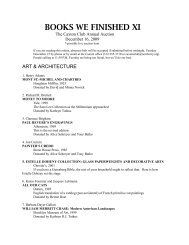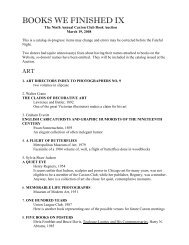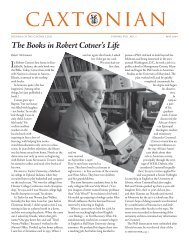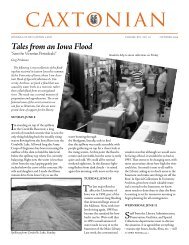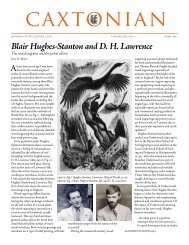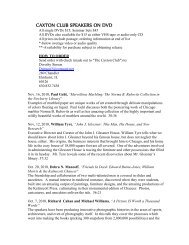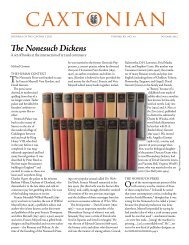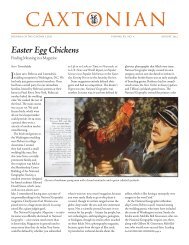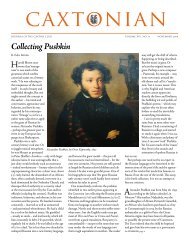The Joys of Joseph Wechsberg - The Caxton Club
The Joys of Joseph Wechsberg - The Caxton Club
The Joys of Joseph Wechsberg - The Caxton Club
You also want an ePaper? Increase the reach of your titles
YUMPU automatically turns print PDFs into web optimized ePapers that Google loves.
caxtonian<br />
JOURNAL OF THE CAXTON CLUB VOLUME XIX, NO. 11 NOVEMBER 2011<br />
<strong>The</strong> <strong>Joys</strong> <strong>of</strong> <strong>Joseph</strong> <strong>Wechsberg</strong><br />
A life well spent, colliding with the English language over food and music<br />
Bruce Hatton Boyer<br />
first encountered the world <strong>of</strong> <strong>Joseph</strong><br />
I <strong>Wechsberg</strong> exactly 50 years ago, and in<br />
a most appropriate place – in the library<br />
aboard the S.S. Flandre, then the workhorse<br />
<strong>of</strong> the French Line’s trans-Atlantic run. I was<br />
15 years old and headed for a three-month<br />
tour <strong>of</strong> Europe with my family. <strong>The</strong> book in<br />
question was a battered Penguin paperback<br />
<strong>of</strong> Looking For a Bluebird, the first compilation<br />
<strong>of</strong> <strong>Wechsberg</strong>’s writings. I say the setting<br />
was appropriate because half the adventures<br />
related in Bluebird centered on <strong>Wechsberg</strong>’s<br />
life as a ship’s musician aboard – what else?<br />
– the French Line.<br />
<strong>Joseph</strong> <strong>Wechsberg</strong> has been gone for 25<br />
years now and while his<br />
writing is both timeless and <strong>of</strong><br />
the moment, pigeonholing his<br />
oeuvre is hard. He could be<br />
classified a bon vivant, though<br />
that word conjures up images<br />
<strong>of</strong> Lucius Beebe, and <strong>Wechsberg</strong><br />
was far wiser and more<br />
accomplished. To call him<br />
a travel writer is to put him<br />
with peddlers <strong>of</strong> Chamber <strong>of</strong><br />
Commerce encomiums. He<br />
was above all a staff writer at<br />
<strong>The</strong> New Yorker for 30 years,<br />
adhering to Wallace Shawn’s<br />
dictum to “delight and satisfy”<br />
the readers. He contributed,<br />
by my count, 156 pieces (an<br />
essentially complete list is at<br />
www.josephwechsberg.com/<br />
html/wechsberg-new_yorkerarticles-1950s.html)<br />
and published<br />
27 books.<br />
<strong>The</strong> New Yorker is a temple<br />
<strong>of</strong> Strunk & White prose, and<br />
most writers can only dream<br />
<strong>of</strong> making the grade there.<br />
<strong>Wechsberg</strong> was one <strong>of</strong> its<br />
most fluid, engaging writers,<br />
and when we consider<br />
that English was his<br />
fourth language, we<br />
can only shake our<br />
heads in awe. And<br />
if to be a writer is to<br />
be an observer <strong>of</strong> life,<br />
even more a participant,<br />
<strong>Wechsberg</strong> was<br />
in a class by himself.<br />
<strong>Joseph</strong> <strong>Wechsberg</strong><br />
was born in Ostrava,<br />
Moravia in 1908<br />
and grew up both<br />
in the countryside<br />
and in Prague. Like<br />
his contemporary in<br />
the “Paris <strong>of</strong> the East,”<br />
Franz Kafka, <strong>Wechsberg</strong><br />
was Jewish, so he<br />
had three languages<br />
right <strong>of</strong>f – Czech,<br />
German and a smattering<br />
<strong>of</strong> Yiddish. His<br />
family shipped him <strong>of</strong>f<br />
to Paris for schooling<br />
after World War I but<br />
instead <strong>of</strong> studying<br />
law as his mother had<br />
wished, <strong>Wechsberg</strong><br />
spent his time playing<br />
violin in seedy Montmartre<br />
nightclubs.<br />
Bluebird contains<br />
hilarious anecdotes<br />
from those years.<br />
<strong>The</strong>re was, for<br />
example, Sebastiano, a piano player so lazy<br />
that he never went home to sleep, preferring<br />
instead to sack out at the nightclub beneath<br />
his piano. One day his tuxedo was stolen<br />
so he played the evening set in his pajamas.<br />
Two Americans discovered him behind a<br />
potted plant, shouted with joy, and for five<br />
nights, all the patrons <strong>of</strong> the Rendezvous des<br />
Americains danced in their pajamas. C’était<br />
le rage. <strong>The</strong> Bluebird <strong>of</strong> the title came from<br />
a black American jazz band known as the<br />
Blackbirds, with whom <strong>Wechsberg</strong> had to play<br />
one night entirely without rehearsal. Since<br />
this was when <strong>Joseph</strong>ine Baker was electrifying<br />
Paris with American jazz, <strong>Wechsberg</strong> and<br />
his five fellow string players were supposed<br />
to accompany a chorus line <strong>of</strong> crinoline-clad<br />
dancers in a Southern plantation number<br />
to the tune <strong>of</strong> Boccherini’s “Minuet.” Don’t<br />
ask. On the second repetition opening night,<br />
the 50-member band blared in, turning the<br />
18th-century Italian chamber piece into a jazz<br />
can-can, and one <strong>of</strong> the dancers broke into<br />
“I’m a Little Bluebird Looking for a Bluebird.”<br />
<strong>The</strong> audience loved it. <strong>The</strong> revue played for<br />
See JOSEPH WECHSBERG, page 2<br />
http://josephwechsberg.com/
oC A X T O N I A N<br />
<strong>Caxton</strong> <strong>Club</strong>, Founded 1895<br />
Bruce H. Boyer, President<br />
Thomas E. Swanstrom, Vice-President<br />
Jo Ellen Dickie, Secretary<br />
Don Chatham, Treasurer<br />
David S. Mann, Past President<br />
Council<br />
Class <strong>of</strong> 2012<br />
Susan Hanes<br />
Robert McCamant<br />
Margaret Oellrich<br />
Morrell McKenzie Shoemaker, Jr.<br />
Mary S. Williams<br />
Class <strong>of</strong> 2013<br />
Matthew Doherty<br />
Tom Joyce<br />
Nancy Lynn<br />
Lynn Martin<br />
Jackie Vossler<br />
Class <strong>of</strong> 2014<br />
Michael Gorman<br />
Celia Hilliard<br />
Wendy Husser<br />
Hal Kugeler<br />
Dorothy Sinson<br />
Appointed Officers<br />
Jill Gage, Programs<br />
Paul F. Gehl, Archivist-Historian<br />
Hayward R. Blake, FABS<br />
Representative<br />
Committees<br />
Margaret Oellrich, Audio Visual<br />
J. William Locke, Dorothy Sinson<br />
(Co-Chairs), Friday Luncheons<br />
Dan “Skip” Landt, Membership<br />
Susan Rossen, Kim Coventry,<br />
Publications and Exhibitions<br />
Martha Chiplis, Scholarship<br />
Charles Spohrer, John M. Dunlevy,<br />
Matthew Doherty, Web Site and<br />
Directory<br />
<strong>Caxton</strong> <strong>Club</strong> Staff<br />
Dan Crawford, General Manager<br />
<strong>Caxton</strong>ian<br />
Robert McCamant, Editor<br />
Brenda Rossini, Copy Editor<br />
Robert Cotner, Founder<br />
Matthew J.Doherty, Wendy Husser,<br />
Paul Ruxin, Florence Shay,<br />
Contributing Editors<br />
©2011, <strong>Caxton</strong> <strong>Club</strong>. <strong>The</strong> <strong>Caxton</strong>ian is published<br />
monthly by the <strong>Caxton</strong> <strong>Club</strong>, whose <strong>of</strong>fice is<br />
in the Newberry Library. Printing: Envision<br />
Graphics, LLC, Bloomingdale, IL.<br />
JOSEPH WECHSBERG, from page 1<br />
months.<br />
<strong>Wechsberg</strong>’s Paris sojourn ended when he<br />
returned at 2 a.m. to his hotel in Pigalle – one which<br />
rented more by the hour than the night – to find his<br />
patron and uncle Siegfried sitting at a sidewalk table<br />
surrounded by females <strong>of</strong> the night and looking not<br />
at all pleased:<br />
I sat down next to him on the terrace. That, it turned<br />
out, was a mistake. Several <strong>of</strong> my North African economics<br />
teachers came by and tried to sell my uncle<br />
genuine Tabriz rugs from the Boches-du-Rhone<br />
department, and one, Mohammed ben Ali, sat down<br />
beside us, <strong>of</strong>fered my uncle his young sister and the<br />
white stuff that looked like, but wasn’t, sugar, and<br />
told me that he’d just won a three-hundred meter<br />
race against an aging brigadier [policeman]. <strong>The</strong>n<br />
<strong>The</strong>ophile and Claudia dropped in. Claudia kissed<br />
me on the cheek and <strong>The</strong>ophile paid me thirty francs<br />
for last Sunday’s work. My uncle wanted to know<br />
what the money was for. I told him proudly about<br />
my job playing with <strong>The</strong>ophile and Son Orchestre.<br />
My uncle said nothing but his face took on the hue<br />
<strong>of</strong> moldy herring. Miss Vintage Bordeaux ambled by,<br />
stopping at our table, giving me a kiss on the cheek<br />
and asking, “Ca va, cherie?” She winked at my uncle<br />
and said there was nothing she would deny a friend<br />
<strong>of</strong> mine, and then gave him an affectionate kiss on<br />
the cheek and pulled up a chair.” (Blue, pp.49-50).<br />
An escape to sea seemed best at that juncture, so<br />
<strong>Wechsberg</strong> signed up with the French Line. This<br />
being during Prohibition, he spent his days in New<br />
York harbor selling overpriced whiskey in cramped<br />
ship cabins to alcohol-deprived New Yorkers. Later,<br />
traversing the Red Sea on the Oriental run, the<br />
ship’s orchestra got into a labor dispute with the<br />
purser and rebelled by rolling the piano overboard.<br />
<strong>The</strong>n there was the overbearing woman dubbed the<br />
High Voltage Lady because the pianist “would rather<br />
sit in the electric chair than in her lap.” When she<br />
insisted on entertaining fellow passengers at the<br />
Captain’s Gala with a rendition <strong>of</strong> “Vissi d’Arte,” said<br />
pianist quietly neglected to transpose the piece down<br />
as requested, killing any possibility <strong>of</strong> her hitting the<br />
high D at the finale and assuring her humiliation.<br />
Sabotage richly deserved.<br />
<strong>The</strong>re were other adventures for <strong>Wechsberg</strong><br />
during the Thirties as well, as in the time he met a<br />
printing-press salesman from Pittsburgh in Ostrava.<br />
Business was horrible, the man told him. Nobody<br />
wanted to buy from him because they didn’t believe<br />
he was an American. No problem. <strong>Wechsberg</strong><br />
dressed him up in a zoot suit, stuck a fat stogie in<br />
his mouth and instructed him to talk like Al Capone.<br />
<strong>The</strong> act established his bona fides, and the man had<br />
the best sales trip <strong>of</strong> his career. Shortly after that<br />
encounter, <strong>Wechsberg</strong> spent time as a claquer – a<br />
pr<strong>of</strong>essional applauder – at the Vienna Opera, and<br />
his descriptions <strong>of</strong> jealous prima donnas and tenors<br />
outbidding each other for his services are unbelievable.<br />
He even did a stint as an assistant croupier in a<br />
Riviera casino.<br />
In the later Thirties, <strong>Wechsberg</strong> fled Hitler and<br />
<strong>Wechsberg</strong>, left, with his wife Ann and Clark Gable. Note that the <strong>of</strong>ficial studio caption on the photograph called<br />
him <strong>Joseph</strong> Warren.<br />
<strong>The</strong> <strong>Caxton</strong> <strong>Club</strong> • 60 W. Walton St., Chicago, IL 60610-3305 • ph 312-255-3710 • caxtonclub@newberry.org • www.caxtonclub.org
Illustrations from Bluebird by Eugen F. Strobel<br />
settled in Los Angeles, at the time a haven for<br />
Central European artistic refugees. It is hard<br />
today to jibe our image <strong>of</strong> West Coast surfers<br />
with the likes <strong>of</strong> Bertolt Brecht, Igor Stravinsky,<br />
Gregor Piatigorsky, Jascha Heifetz and<br />
Arnold Schoenberg, but they were all there. A<br />
stint at Paramount Pictures taught <strong>Wechsberg</strong><br />
the difference between Hollywood “writers”<br />
and the real thing:<br />
At a dinner party in the house <strong>of</strong> a Hollywood<br />
producer (I seem to have been invited by<br />
a clerical error), the guest <strong>of</strong> honor was an<br />
English novelist whose minor literary talent<br />
was camouflaged by his major conceit. He<br />
was treated as though he’d won the Nobel<br />
Prize. Way down the table sat Thomas Mann,<br />
who had been awarded the Nobel Prize for<br />
Literature in 1929. He was ignored by the<br />
host and hostess. Later, another move mogul<br />
slapped Mann on the shoulder and called him<br />
“Tommy.” (First, p. 119)<br />
It was in those years that <strong>Wechsberg</strong> decided<br />
to become a writer by, as he put it, “continuing<br />
my lonely collision course with the English<br />
language.” He wrote six, eight and ten hours<br />
a day, sending manuscripts out by the dozen<br />
and receiving rejection slips by the same<br />
number. After many attempts, he landed one<br />
at <strong>The</strong> New Yorker, where he stayed – with<br />
time out for Army intelligence work during<br />
World War II – until his death.<br />
<strong>Wechsberg</strong> could have written just about<br />
his own adventures and held audiences captive.<br />
But he was also a journalist who pursued<br />
stories with tenacity and warmth, a rare combination.<br />
His range was extraordinary. Among<br />
his New Yorker pieces in the 1950’s were an<br />
article about the Leipzig Trade Fair, the newlyreopened<br />
Bristol Hotel in Vienna, the 500th<br />
birthday celebration for Columbus in Genoa,<br />
the reconstituted Greek National Army, the<br />
independence <strong>of</strong> Libya, reports <strong>of</strong> corresponding<br />
visits to Morocco and Tangier, a piece<br />
on rubble removal on postwar Berlin, on the<br />
Haydn Society in Vienna – a group dedicated<br />
to recording all <strong>of</strong> the master’s music, pr<strong>of</strong>iles<br />
<strong>of</strong> the director <strong>of</strong> the Hamburg State<br />
Opera and Albert Schweitzer, a review <strong>of</strong> a<br />
performance <strong>of</strong> Nozze di Figaro at the Gran<br />
Teatre de Liceu in Barcelona, a visit to the<br />
Casa Verdi in Sant’ Agata, the opening <strong>of</strong> the<br />
reconstructed Staatsoper in Vienna, and even a<br />
pr<strong>of</strong>ile <strong>of</strong> the inventors <strong>of</strong> Kodachrome film.<br />
<strong>The</strong> New Yorker sent him to report from<br />
Prague, Warsaw, Bucharest and Budapest<br />
as they struggled to rebuild themselves after<br />
World War II. Speaking the native languages<br />
as he did, his reports combined the journalist’s<br />
eye with the novelist’s feel for the human. And,<br />
like any good journalist, he always stayed on<br />
the lookout for stories that his editors had not<br />
imagined. Indeed, his favorite piece was his<br />
most serendipitous.<br />
In 1954, he was motoring through St.<br />
Anton-am-Arlberg, a small Tyrolean village.<br />
Thinking his brakes were overheating, he<br />
pulled <strong>of</strong>f onto a small dirt road. Forced to a<br />
stop by crossing cattle, he noticed the eastern<br />
portal <strong>of</strong> the Arlberg Tunnel, one <strong>of</strong> the<br />
longest railroad tunnels in the world – six and<br />
a quarter miles – and saw a man walking out<br />
<strong>of</strong> the tunnel in overalls and carrying a carbide<br />
lamp. He looked like a coal miner. Intrigued,<br />
<strong>Wechsberg</strong> discovered his name was Johann<br />
Raffeiner, and he was the Streckenbegehrer, or<br />
track inspector. His job was to walk the tunnel<br />
every day and check for loose ties. Since the<br />
trip took eight hours, Raffeiner would inspect<br />
the rails in one direction one day, then the<br />
other track the next, 32,000 railroad ties in all.<br />
Intrigued, <strong>Wechsberg</strong> accompanied him.<br />
Eight hours later I stumbled and almost fell<br />
down when we reached the western exit at<br />
Langen. I stared at the lovely picture <strong>of</strong> blue<br />
skies and white clouds, <strong>of</strong> mountains and<br />
trees and colors, framed by the tunnel portal.<br />
Walking through a long, dark tunnel may<br />
be a poor substitute for an astronaut’s walk<br />
through space, but to me it was a little like<br />
getting back to earth. . . Fellow mortals, if you<br />
ever get bored with life on earth, walk through<br />
a long tunnel. (First, p. 305)<br />
<strong>Wechsberg</strong>’s major loves were food and<br />
music. Being a man <strong>of</strong> so many differ-<br />
See JOSEPH WECHSBERG, page 4<br />
CAXTONIAN, NOVEMBER 2011 3
http://www.flickr.com/photos/37263611@N05/4404953415/<br />
JOSEPH WECHSBERG, from page 3<br />
ent places and cultures, an interest in food<br />
was perhaps inevitable. He never claimed to<br />
be an epicurean – “my promotion to gourmet<br />
coincided with my inability to eat a gourmet<br />
meal. Nowadays, my delicate stomach refuses<br />
to underwrite my palate’s excursions into the<br />
realm <strong>of</strong> gastronomy.” (First, p. 369). He wrote<br />
<strong>of</strong> his mother’s vernacular cooking, <strong>of</strong> nights<br />
in Paris bistros, and a whole piece on the way<br />
Viennese chefs searched out and chose just the<br />
right cuts for their legendary boiled beef:<br />
Old-time Viennese butchers with the steady<br />
hand <strong>of</strong> distinguished brain surgeons were<br />
able to dissect the carcass <strong>of</strong> a steer into thirtytwo<br />
different cuts, and four qualities, <strong>of</strong> meat.<br />
Among the first quality cuts were not only<br />
tenderloin, porterhouse, sirloin and prime<br />
rib <strong>of</strong> beef, as elsewhere, but also five cuts<br />
used exclusively for boiling: two Scherzls, two<br />
Schwanzls, and Tafelspitz.... In Vienna, only<br />
4 CAXTONIAN, NOVEMBER 2011<br />
the very best beef was good enough to be<br />
boiled. (Blue, p. 71)<br />
<strong>Wechsberg</strong> wrote what was perhaps the<br />
introduction to the Guide Michelin for American<br />
audiences and a piece about the Lindt<br />
& Sprungli chocolate factory at Kilchberg,<br />
Switzerland. Inevitably, there were pieces on<br />
famous chefs – Alexandre Dumaine <strong>of</strong> the<br />
Hotel Cote d’Or, Roger Topolinski <strong>of</strong> the<br />
famous Paris restaurant Lapérouse, Henri<br />
Soule, who opened le Pavillon in 1939, America’s<br />
first real haute cusine restaurant, and<br />
Fernand Point, the legendary proprietaire <strong>of</strong><br />
La Pyramide, considered the greatest French<br />
restaurant in history. Point was six foot three,<br />
weighed over 300 hundred pounds, and had<br />
a face like a traffic cop but his love <strong>of</strong> cooking<br />
made him seem almost elfin:<br />
“Of course, there is no such thing as perfection.<br />
But I always try to make every meal,” he<br />
closed his eyes, searching for the right words,<br />
“ – une petit merveille. Now, you wouldn’t<br />
believe it, but I gave a lot <strong>of</strong> thought to your<br />
lunch. I said to myself, ‘Maybe he should have<br />
a sole aux nouilles instead <strong>of</strong> the truite au porto.’<br />
I decided against it. It might have been too<br />
much, and I don’t want my clients to eat too<br />
much. Only in bad restaurants is one urged<br />
to order a lot. Enfin, you are satisfied.” (Blue,<br />
p. 281).<br />
When Point died in 1954, his wife took<br />
over the restaurant and aficionados around<br />
the world wondered if the Michelin third star<br />
would disappear. It did not, and <strong>Wechsberg</strong><br />
returned again in 1963 to write a pr<strong>of</strong>ile <strong>of</strong> her.<br />
In the end, it was music that ruled <strong>Wechsberg</strong>’s<br />
life. His years as a pr<strong>of</strong>essional musician<br />
gave him insight into the making <strong>of</strong> music,<br />
and he wrote masterful pieces about it from<br />
every conceivable angle. He pr<strong>of</strong>iled musicians<br />
– Isaac Stern, Artur Rubenstein, George Szell<br />
and the Cleveland Orchestra, the Budapest<br />
String Quartet, Anton Karas, the Viennese<br />
zither player who composed and played the<br />
famous theme from <strong>The</strong> Third Man, and<br />
Franz Allers, the man who sold the idea <strong>of</strong><br />
adopting Pygmalion to Lerner and Lowe, a feat<br />
that took five years to bear fruit. He wrote<br />
a biography <strong>of</strong> Verdi, and he interviewed<br />
and/or hobnobbed with opera singers <strong>of</strong> three<br />
generations.<br />
Above all he wrote about his greatest love,<br />
the violin. Like any violinist, <strong>Wechsberg</strong><br />
started on cheap factory instruments back in<br />
Czechoslovakia, and had more than his share<br />
<strong>of</strong> mishaps with violins during his itinerant<br />
years, including the time he forgot to refrigerate<br />
his while on a hot run through Indonesian<br />
waters and found it the next morning a pile <strong>of</strong><br />
melted glue. In the 1950’s he made a pilgrimage<br />
to Cremona in search <strong>of</strong> Stradivarius,<br />
Guarneri and Amati’s ghosts, and managed to<br />
locate Stradivarius’ great-great-great grandson.<br />
Like any violinist, <strong>Wechsberg</strong> dreamed <strong>of</strong><br />
one day owning a Stradivarius. He wrote a<br />
pr<strong>of</strong>ile <strong>of</strong> Emil Hermann, the premier violin<br />
dealer in New York and purveyor <strong>of</strong> instruments<br />
to the world’s great players. One day<br />
Hermann invited <strong>Wechsberg</strong> to his country<br />
house in Connecticut – nicknamed Fiddledale<br />
– and walked the writer through his vault <strong>of</strong><br />
priceless antique instruments. At that time,<br />
<strong>Wechsberg</strong> had already managed to afford<br />
an Amati, but then Hermann showed him a<br />
Strad the master had made when he was 86:<br />
Painting <strong>of</strong> Fernand Point by Michelle Ochs.<br />
<strong>Wechsberg</strong> wrote about both the oversize chef<br />
and his wife, who took over for him.
He handed me the violin and<br />
a bow. <strong>The</strong> violin responded to<br />
the slightest pressure <strong>of</strong> the bow,<br />
and it sang like a human voice.<br />
Its tone was both s<strong>of</strong>t and penetrating,<br />
sweet and forceful. With<br />
this violin I would no longer be<br />
outplayed by my ta-ta-ing fellow<br />
players.<br />
Of course there was no choice<br />
but to buy it. Getting used to<br />
it took <strong>Wechsberg</strong> three years.<br />
“Sometimes I envy my Stradivarii.<br />
At the age <strong>of</strong> two hundred and<br />
forty years, [it] shows no sign <strong>of</strong><br />
growing old.”<br />
After traveling almost everywhere<br />
in the world, after meeting<br />
hundreds <strong>of</strong> extraordinary people<br />
and coaxing out their stories<br />
in four different languages, and<br />
after living in dozens <strong>of</strong> different<br />
cities on four different continents,<br />
<strong>Wechsberg</strong> decided to spend his<br />
last years in his most beloved city,<br />
Vienna, where he died in 1983.<br />
But his words live on. I know<br />
<strong>of</strong> no other writer who wrote<br />
about so many different topics<br />
with such clarity, such enthusiasm,<br />
and such empathy. His life<br />
could have been a bitter one – his Isaac Stern<br />
mother died at Auschwitz – but it<br />
was instead one filled with wonder and such<br />
a sheer passion for the beauties <strong>of</strong> life that his<br />
work can be read and re-read endlessly.<br />
So where should the intrigued reader<br />
begin? At the beginning with Looking For a<br />
Bluebird, published by Houghton Mifflin in<br />
1945 (I have both the first edition and the<br />
same battered Penguin paperback I first read<br />
back in 1962!). For those interested in food, I<br />
suggest Blue Trout and Black Truffles (Knopf,<br />
1966), <strong>The</strong> Best Things in Life (Weidenfeld &<br />
Nicolson, 1964) and Trifles Make Perfection,<br />
an anthology put together in 1999 by David<br />
Morowitz, a devoted fan. Some <strong>of</strong> the essays<br />
are duplicated between these volumes but they<br />
are all worth perusing. <strong>Wechsberg</strong> also wrote<br />
<strong>The</strong> Cooking <strong>of</strong> Vienna’s Empire for Time-Life<br />
Books in 1968, an experience he described as<br />
filled with fancy lunches in New York mixed<br />
with unending memos from anonymous<br />
readers from all over the Luce empire.<br />
For music lovers, there is an embarrassment<br />
<strong>of</strong> riches – <strong>The</strong> Glory <strong>of</strong> the Viol (Viking,<br />
1973) and <strong>The</strong> Opera (MacMillan, 1972), a<br />
combination <strong>of</strong> history and analysis that is as<br />
good an introduction to the form as I know.<br />
Along the same lines is his biography Verdi<br />
(Putnam’s Sons, 1974). It stands between two<br />
classic works – Francis Toye’s Verdi: His Life<br />
and Works (Knopf, 1946), a clean biography<br />
combined with highly-opinionated analyses<br />
<strong>of</strong> the operas, and Mary Jane Phillips-Matz’<br />
monumental Verdi (Oxford, 1993), a book<br />
so completely definitive it numbs the mind.<br />
<strong>Wechsberg</strong>’s book is popular in the best sense<br />
<strong>of</strong> the word – easily-engaged, knowledgeable<br />
but never pedantic, clear and bright but never<br />
breezy.<br />
And finally, there is <strong>The</strong> First Time Around<br />
(Little, Brown, 1970), as close to an autobiography<br />
as <strong>Wechsberg</strong> ever wrote. It is filled<br />
with behind-the-scenes anecdotes as well as<br />
trenchant observations, among them one <strong>of</strong><br />
the finest explanations <strong>of</strong> the writer’s craft I<br />
have ever read:<br />
Sometimes I work on a story, talking to<br />
people and taking notes, but it’s all dull and<br />
pedestrian, and I’m beginning to wonder<br />
whether I wasn’t wrong about the story<br />
– whether there is a story at all. I seem to be<br />
up against an invisible wall, and I<br />
feel, unhappily, that it just doesn’t<br />
work. <strong>The</strong>re is no inner excitement.<br />
If I am not fascinated, how can I<br />
convey my fascination to others?<br />
I’ve wasted my time, and I can’t<br />
even write it <strong>of</strong>f to experience.<br />
And then, suddenly and inexplicably,<br />
it happens. Something<br />
sparks inside me. I’ve established<br />
a secret connection with the other<br />
person who tells me what I hoped<br />
all along he would. <strong>The</strong> story is<br />
there, and it’s an exciting story, and<br />
I have a sense <strong>of</strong> exhilaration. My<br />
blood pressure goes up, my hands<br />
begin to tremble. I write fast now,<br />
much too fast that sometimes I’m<br />
later unable to decode my own<br />
notes. It is like the sensation I<br />
noticed around the roulette table<br />
when a gambler has a winning<br />
streak. Unless he keeps a cool head,<br />
it may all be gone. <strong>The</strong> gambling<br />
writer, too, is afraid <strong>of</strong> losing the<br />
story, <strong>of</strong> not being able to hold<br />
onto it. One needs discipline and<br />
a sense <strong>of</strong> self-control, to remain<br />
intent and alert until one feels that<br />
one has got the story. (First, p. 329).<br />
<strong>Wechsberg</strong> always got the<br />
story. Hundreds <strong>of</strong> them, each one<br />
honest, intriguing, compassionate<br />
and above all, thoroughly delightful.<br />
§§<br />
CAXTONIANS COLLECT, from page 7<br />
to make. “In the last five years all three librarians<br />
have made trips to the African continent<br />
for multiple purposes including acquisitions,”<br />
he says. (Other reasons include grants, conference<br />
participation, etc.). “But I go most<br />
frequently.”<br />
David moved to Chicago in 1983 with<br />
his partner, Richard Bough, an artist and<br />
teacher. After teaching painting and drawing<br />
at the Latin School for 17 years, Richard<br />
now devotes himself completely to his own<br />
artwork. Whenever possible, Richard accompanies<br />
David on his African trips. Several<br />
summers ago they drove across the South<br />
African karoo from Cape Town to Durban<br />
along with a South African book dealer friend<br />
visiting artists’ studios, regional museums, and<br />
bookshops.<br />
§§<br />
CAXTONIAN, NOVEMBER 2011 5
Book and manuscript-related<br />
exhibitions: a selective list<br />
Compiled by Robert McCamant<br />
(Note: on occasion an exhibit may be delayed or<br />
extended; it is always wise to call in advance <strong>of</strong> a visit.)<br />
Art Institute <strong>of</strong> Chicago, 111 S. Michigan Avenue, Chicago, 312-443-<br />
3600: “Torii Kiyonaga and Ideal Beauty in Japanese Prints” (ukiyoe<br />
prints), Gallery 107, through December 11. “Bertrand Goldberg:<br />
Architecture <strong>of</strong> Invention” (retrospective <strong>of</strong> the architect’s work),<br />
Galleries 283–285, through<br />
January 15. “Jürgen Mayer H.:<br />
Wirrwarr” (envelopes lined with<br />
patterns and codes designed<br />
to keep the contents private),<br />
Gallery 24, through January 22.<br />
Chicago Botanic Garden, Lenhardt<br />
Library, 1000 Lake Cook Road,<br />
Glencoe, 847-835-8202: “Highgrove<br />
Florilegium” (an <strong>of</strong>ficial<br />
chronicle <strong>of</strong> the plants growing<br />
in the gardens <strong>of</strong> the Prince <strong>of</strong><br />
Wales at Highgrove in Gloucestershire),<br />
through February 12.<br />
Chicago History Museum, 1601 N.<br />
Clark Street, Chicago, 312-266-<br />
2077: “Out in Chicago” (150<br />
years <strong>of</strong> urban history through<br />
the lens <strong>of</strong> gender, sexuality, and<br />
nonconformity), Bessie Green-<br />
Field Warshawsky Gallery,<br />
through March 26.<br />
Harold Washington Library Center,<br />
400 S. State Street, Chicago,<br />
312-747-4300: “One Book, Many<br />
Interpretations: Second Edition”<br />
(commemorates the program’s<br />
10-year anniversary with a juried<br />
exhibition by bookbinders<br />
and book artists interpreting<br />
the 10 most recent selections;<br />
judges were <strong>Caxton</strong>ians Paul<br />
Gehl, Audrey Niffenegger, and<br />
Norma Rubovitz), Special Collections Exhibit Hall, Ninth Floor,<br />
through April 15.<br />
DuSable Museum <strong>of</strong> African American History, 740 East 56th Place,<br />
Chicago, 773-947-0600: “Everywhere with Roy Lewis” (a narrative<br />
<strong>of</strong> the African American experience spanning five decades),<br />
through December 31.<br />
Lake Forest-Lake Bluff Historical Society, 361 E. Westminster Avenue,<br />
Lake Forest, 847-234-5253: “Uncanny, Unabridged, Unforgettable:<br />
150 Years <strong>of</strong> Lake Forest” (honors Lake Forest’s Sesquicentennial),<br />
through December 29.<br />
Museum <strong>of</strong> Contemporary Art, 220 East Chicago Avenue, Chicago,<br />
312-280-2660: “Ron Terada: Being <strong>The</strong>re” (work that includes<br />
6 CAXTONIAN, NOVEMBER 2011<br />
Smart Museum: Process and Artistry in the Soviet Vanguard<br />
Gustav Klucis, Long Live Red Army <strong>of</strong> Workers and Peasants, 1935. Poster. © 2011<br />
Estate <strong>of</strong> Gustav Klutsis / Artists Rights Society (ARS), New York.<br />
paintings, photographs, video, sound, books, and graphic design by<br />
this Vancover artist), through January 15.<br />
Newberry Library, 60 W. Walton Street, Chicago, 312-943-9090: “Indians<br />
<strong>of</strong> the Midwest” (items from its collections, including: early colonial<br />
maps denoting Indian communities; rare books and manuscripts<br />
related to indigenous cultures from the early colonial period to the<br />
present; and drawings and paintings depicting Indian life in the<br />
Midwest), through December 31.<br />
Northwestern University, Block Museum <strong>of</strong> Art, 40 Arts Circle Drive,<br />
Evanston, 847-491-4000: “Tango with Cows: Book Art <strong>of</strong> the Russian<br />
Avant-Garde, 1910–1917” (the dramatic transformation <strong>of</strong> book art<br />
during the years before the Russian<br />
Revolution), through December 11.<br />
Northwestern University, Charles Deering<br />
Library, 1970 Campus Drive, Evanston,<br />
847-491-7658: “Papering Over Tough<br />
Times: Soviet Propaganda Posters <strong>of</strong><br />
the 1930s,” Special Collections, through<br />
June 15.<br />
Oriental Institute, 1155 East 58th Street,<br />
Chicago, 773-702-9514: “Before the<br />
Pyramids: the Origins <strong>of</strong> Egyptian<br />
Civilization” (the most fundamental<br />
aspects <strong>of</strong> ancient Egyptian civilization<br />
– architecture, hieroglyphic writing, a<br />
belief in the afterlife, and allegiance to<br />
a semi-divine king – can be traced to<br />
Egypt’s Predynastic and Early Dynastic<br />
eras), through December 31.<br />
Smart Museum <strong>of</strong> Art, 5550 S. Greenwood<br />
Avenue, Chicago, 773-702- 0200:<br />
“Process and Artistry in the Soviet<br />
Vanguard” (exposes the experimental<br />
creative processes that generated iconic<br />
Soviet propaganda in the 1920s and<br />
1930s), through January 22.<br />
University <strong>of</strong> Chicago, <strong>Joseph</strong> Regenstein<br />
Library, 1100 East 57th Street, Chicago,<br />
773-702-8705: “Adventures in the<br />
Soviet Imaginary” (the Soviet Union<br />
as a world in pictures, facilitated by a<br />
vibrant image culture based largely on<br />
new media technologies, is explored<br />
through two <strong>of</strong> its most striking manifestations<br />
– the children’s book and the poster – looked at in the wake<br />
<strong>of</strong> the Russian revolution <strong>of</strong> 1917 and followed by periodic re-makings<br />
– during Stalin’s Great Leap Forward, 1928–1932; World War II,<br />
1941–1945; the Thaw, 1956–1964; and Perestroika, 1987–1991), Special<br />
Collections Research Center Exhibition Gallery, through December 31.<br />
For complete information on events and exhibits <strong>of</strong> the <strong>The</strong> Soviet Arts<br />
Experience, see www.sovietartsexperience.org.<br />
Until a replacement exhibit editor is found, please send your listings to<br />
bmccamant@quarterfold.com, or call 312-329-1414 x 11.
<strong>Caxton</strong>ians Collect: David Easterbrook<br />
Interviewed by Robert McCamant<br />
As it turns out, if you want to research<br />
Africa – its history, its languages, its economics,<br />
even see pictures <strong>of</strong> it – the best place<br />
in the world to do that is right up in Evanston<br />
at Northwestern University. <strong>The</strong> Melville<br />
J. Herskovits Library <strong>of</strong> African Studies is<br />
there, and its curator is the club’s own David<br />
Easterbrook.<br />
“I always loved libraries. I worked in them<br />
part time while in both high school and<br />
college,” he explained. “But then<br />
when I was in college I went to<br />
Nairobi on a special program,<br />
and I was hooked on Africa.”<br />
After graduation, he went back<br />
to Kenya with the Peace Corps.<br />
When that was over, he began to<br />
think about whether there was a<br />
way to combine his two interests,<br />
Africa and libraries.<br />
“Two <strong>of</strong> my Africa mentors<br />
at Kalamazoo College were<br />
graduates <strong>of</strong> the PhD program<br />
in African Studies at Northwestern.<br />
<strong>The</strong>y gave me a resounding<br />
yes, and said that the job I<br />
really wanted was to curate the<br />
Herskovits Library.” He got the<br />
requisite degrees and worked in<br />
other Africa collections. <strong>The</strong>n<br />
he came to Chicago and was<br />
Principal Bibliographer at UIC<br />
with Gretchen Lagana. When<br />
the Northwestern curatorship<br />
opened up in 1991, he was a convenient<br />
choice.<br />
He says the last twenty years<br />
have been quite a ride. <strong>The</strong> University<br />
intensively built the collection<br />
from its founding in 1954<br />
with a focus on the ever-expanding publishing<br />
output <strong>of</strong> the developing continent plus what<br />
current materials were being published around<br />
the world (as <strong>of</strong> today, the Herskovits Library<br />
has 400,000 volumes and subscriptions to<br />
2800 periodicals). But Easterbrook and the<br />
Library’s Development Office had bigger ideas.<br />
If major funds could be raised in advance,<br />
then when important retrospective collections<br />
became available, Northwestern would be first<br />
in line to purchase them.<br />
As it turned out, donors liked the idea. Two<br />
<strong>of</strong> the Library’s major sub-collections (the<br />
Winterton Collection <strong>of</strong> East African Pho-<br />
tographs and the E.H. Duckworth Nigerian<br />
Photographic Archive) were acquired early<br />
this century with such funds. Another important<br />
sub-collection, Arabic Manuscripts from<br />
West Africa, was acquired primarily with NU<br />
funds thanks to the diligent efforts <strong>of</strong> several<br />
Northwestern pr<strong>of</strong>essors who painstakingly<br />
assembled the collection during years <strong>of</strong> travel<br />
and negotiation. Of course, Easterbrook’s eyes<br />
are always open to other important groups<br />
<strong>of</strong> material which are susceptible <strong>of</strong> being<br />
snatched up.<br />
But an increasing part <strong>of</strong> his time these days<br />
goes toward finding ways to share the material<br />
they already have with the world. <strong>The</strong> Winterton<br />
collection as well as portions <strong>of</strong> the map<br />
and poster collections have been digitized, and<br />
are now available for study to anyone online.<br />
And academics – from high school teachers to<br />
graduate students – are constantly making the<br />
pilgrimage to Northwestern to use the materials<br />
in person. <strong>The</strong>re are even regular on-site<br />
seminars for high school teachers to suggest<br />
things that can be done with the materials.<br />
A staff <strong>of</strong> six, three librarians and three<br />
library assistants, make it all possible with<br />
enormous support from the NU Library<br />
Technical and Digital Services operations.<br />
<strong>The</strong> world is quite interested in the collection,<br />
it turns out. When there was publicity<br />
after the Winterton collection was digitized,<br />
inquiries came in on diverse topics, including<br />
one person who wanted a photo <strong>of</strong> Freddie<br />
Mercury’s birthplace in Zanzibar (which<br />
they didn’t have). And the election <strong>of</strong> Barack<br />
Obama has inspired even closer examination<br />
<strong>of</strong> the Kenyan material in the collection.<br />
Among the things that have been discovered:<br />
a description <strong>of</strong> the clan to<br />
which the Obamas belong;<br />
a book (in Luo, a Kenyan<br />
language) from 1959, and<br />
journal article, from 1965, by<br />
his father; and the various<br />
addresses his father lived<br />
in Nairobi, discovered from<br />
the many Nairobi telephone<br />
directories in the collection.<br />
When Northlight and<br />
Remy Bumppo theater<br />
companies were producing<br />
Africa-related plays<br />
last season, they came to<br />
Northwestern for images.<br />
When the Folio Society<br />
republished Scramble for<br />
Africa last month, they illustrated<br />
it with pictures from<br />
Northwestern. <strong>The</strong> Smithsonian’s<br />
2010-11 Lorenzo<br />
Dow Turner exhibit (held at<br />
the Anacostia Community<br />
Museum) relied mainly on<br />
its own Turner collection,<br />
but came to Northwestern<br />
for missing pieces.<br />
Easterbrook’s personal<br />
collecting is not a great<br />
distance from his work. He likes paperbacks,<br />
and has amassed a collection <strong>of</strong> paperbacks<br />
with African-themed covers. <strong>The</strong> library has<br />
a facsimile <strong>of</strong> the Hogarth Press edition <strong>of</strong><br />
An African Speaks for His People, but Easterbrook<br />
got a copy <strong>of</strong> the original (Leonard<br />
and Virginia Woolf were responsible) for his<br />
collection. Rebel Destiny is one <strong>of</strong> Herskovits’s<br />
standard works; in honor <strong>of</strong> his 100th birthday<br />
(celebrated in 1995), Easterbrook scoured<br />
the country for a copy with a dust jacket.<br />
One <strong>of</strong> the things Easterbrook most enjoys<br />
about his job is the occasional trips he gets<br />
See CAXTONIANS COLLECT, page 5<br />
CAXTONIAN, SEPTEMBER 2011 7<br />
Photograph by Robert McCamant
CAXTONIAN<br />
<strong>Caxton</strong> <strong>Club</strong><br />
60 West Walton Street<br />
Chicago, IL 60610<br />
USA<br />
Address Correction Requested<br />
Bookmarks...<br />
Luncheon: Friday December 9, 2011, Union League <strong>Club</strong><br />
Sam Ellenport<br />
Harcourt Bindery Stories,<br />
especially including Linked-Spine Bindings<br />
<strong>Caxton</strong>ian Sam Ellenport – author, lecturer, and teacher – has<br />
been proprietor <strong>of</strong> Harcourt Bindery in Boston for the past 40<br />
years. It is the last large book bindery in America still working in a 19th<br />
century tradition, on a par with Bayntun’s in Bath, England. Through<br />
spectacular images, Sam will uncover a rare aspect in bookbinding: the<br />
use <strong>of</strong> the spines <strong>of</strong> books as a canvas on which binders create designs<br />
that span several volumes. He’ll also talk about the history <strong>of</strong> the bindery<br />
(including some early racy stories) – special commissions include a<br />
slipcase to hold Charles Dickens’ sleeping cap – and a bit about his<br />
finishing department’s 2,500 hand tools, and much more.<br />
Sam contributed a piece to Other People’s Books and his leather-bound<br />
hide-your-valuables books have been popular auction items.<br />
<strong>The</strong> December luncheon will take place at the Union League <strong>Club</strong>, 65<br />
W. Jackson Boulevard. Luncheon buffet (in the main dining room on<br />
six) opens at 11:30 am; program (in a different room, to be announced)<br />
12:30-1:30. Luncheon is $30. Details <strong>of</strong> the December dinner: it will take<br />
place in Ruggles Hall at the Newberry Library. Timing: spirits at 5:00,<br />
Beyond December...<br />
JANUARY LUNCHEON<br />
On January 13, 2012, <strong>Caxton</strong>ian<br />
Junie Sinson will speak about<br />
many aspects <strong>of</strong> the Nobel Prize<br />
for Literature, including: just how<br />
does the Swedish Academy reach<br />
their decisions, are criticisms <strong>of</strong><br />
recent selections justified, and what<br />
effect do the choices have on the<br />
direction <strong>of</strong> American and world<br />
literature.<br />
8 CAXTONIAN, NOVEMBER 2011<br />
JANUARY DINNER<br />
Wednesday, January 18 at the Cliff<br />
Dwellers, Regina Buccola (<strong>of</strong><br />
Roosevelt University and Chicago<br />
Shakespeare <strong>The</strong>ater) will talk<br />
about the continuing authorship<br />
debates over the Shakespearean<br />
ouvre. Recent films and books will<br />
be considered.<br />
FEBRUARY LUNCHEON<br />
On February 10, <strong>Caxton</strong>ian Susan<br />
Levy will speak at the Union<br />
League <strong>Club</strong>. She is the longtime<br />
editor <strong>of</strong> the prized Lakeside<br />
Classics, a once-a-year publication<br />
begun by Thomas E. Donnelley<br />
in 1903 and published every year<br />
since to show beautiful blending<br />
<strong>of</strong> technology and craftsmanship.<br />
Susan’s title: “Adventures While<br />
Editing the Lakeside Classics.”<br />
NON PROFIT ORG<br />
US POSTAGE<br />
PAID<br />
PERMIT 1096<br />
CAROL STREAM, IL<br />
Dinner: Wednesday December 14, Newberry Library<br />
Annual Holiday Revels<br />
plus Benefit Auction<br />
Note: Second Wednesday!<br />
Our Holiday Revels will take place at the Newberry Library. In<br />
addition to good food, generous libations, and each other’s company,<br />
we have the opportunity to benefit the <strong>Club</strong> by bidding on books and<br />
book-related items donated by fellow members. (<strong>The</strong>re may be still<br />
time to make donations as you read this: Dan Crawford is accepting<br />
them at the Newberry through Friday, December 9. <strong>The</strong> latest list<br />
<strong>of</strong> items on which to bid can be found at the <strong>Club</strong>’s web site, www.<br />
caxtonclub.org .) Special entertainment is also planned.<br />
dinner at 6:00, followed by live auction and entertainment. Dinner is $48,<br />
drinks are $5. For reservations call 312-255-3710 or email caxtonclub@<br />
newberry.org; reservations are needed by noon Tuesday<br />
for the Friday luncheon, and by noon Friday for the<br />
Wednesday dinner.<br />
FEBRUARY DINNER<br />
We will meet Wednesday, February<br />
15 at the Cliff Dwellers. Suzanne<br />
Karr Schmidt, <strong>of</strong> the Art Institute<br />
<strong>of</strong> Chicago, has tentatively agreed<br />
to talk about the exhibit “Altered<br />
and Adorned: Using Renaissance<br />
Prints in Daily Life.”



